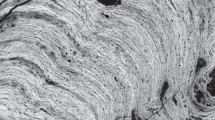Abstract
The biogenic structure and biominerals in the polymetallic nodules reveal their biogenic origin. The experiment of the cation substitution capacity of synthetic 1 nm manganate suggests that chemism participates in the mineralization of the polymetallic nodules. That means the mineralization of the polymetallic nodules is two-component. After discussing the mineralization mechanism, the authors pointed out that the formation of polymetallic modules in deep-sea must meet four prerequisites: oxidative environment, very low sedimentation rate and/or hiatuses, enough nuclei, and suitable for the ultra-microbes-nodule’s builder to live.
Similar content being viewed by others
References
Burns, R.G., Burns, V. M., Mineralogy of manganese nodules, inMarine Manganese Deposits (ed. Glasby, G.P.), New York: Elsevier, 1977.
Wang Chenghou, The separation and accumulation of manganese and iron and the formation of manganese nodules,Sciences in China (in Chinese), Ser. B, 1986, (10): 1100.
Dugolisky, B. K., Margolis, S. K., Dudly, M.C., Biogenic influence on growth of manganese nodules,J. Sed. Petro., 1977, 47(1): 428.
Wang Chongyou, Jin Ruogu, Li Jiayinget al., Biomineralization of Microorganisms and Polymetallic Nodules (in Chinese), Beijing: Geological Publishing House, 1994.
Shi Junxian, Cheng Zhongyuan, Abundance of total bacteria and manganese-oxidizing bacteria in the sediments and manganese nodules of the northwestern Pacific Ocean,Acta Oceanologica Sinica, 1991, 10(1): 141.
Yan Baorui, Zhang Sheng, Zhang Xigenet al., Microbial Activity and Its Mineragenetic of Water-Rock System in the Central Pacific Ocean (in Chinese), Beijing: Geological Pulishing House, 1994.
Zhang Fusheng, Bian Lieng, Lin Chengyiet al., Discovery of the spiral ultra-microfossils in pelagic manganese nodules and their significance,Geological Journal of Universities (in Chinese), 1995, 1(1): 109.
Lin Chengyi, Bian Lizeng, Zhang Fushenget al., Classification of the microbes and study of the beaded ultra-microfossils in pelagic manganese nodules,Chinese Science Bulletin (in Chinese), 1996, 41(9): 821.
Qian Jiangchu, Mellin, T. A., Study on the cation substitution capacity of synthetic 1 nm rnanganate,Acta Oceanologica Sinica, 1996, 15(3): 345.
Bender, M. L., Mechanisms of trace metal removal from the ocean, inFerromanganese Deposits on the Ocean Floor, Washington D.C., IDOENSF, 1972, 73–80.
Okada Hakuyu, I’roblems on sedimentology in hiatus of ocean floor,Marine Sciences Monthly (in Japanese), 1981, 13(2): 112.
Author information
Authors and Affiliations
Additional information
Project supported by the Deep Sea Geologic Research Project of China Oceanic Mineral Resources Research and Development Association (COMRA)
Rights and permissions
About this article
Cite this article
Han, X., Shen, H., Chen, J. et al. Biogenesis and binary mineralization of organism and chemism of polymetallic nodules from Pacific Ocean. Sci. China Ser. D-Earth Sci. 40, 656–661 (1997). https://doi.org/10.1007/BF02877696
Received:
Issue Date:
DOI: https://doi.org/10.1007/BF02877696




